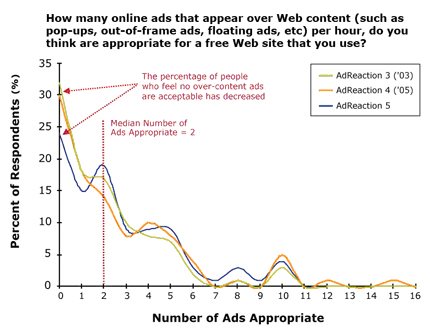





According to eMarketer, online ad spend will continue to grow, despite the economic slowdown, to reach $28.5 billion by 2009 as marketers strive to engage this ever increasing audience. According to research from Dynamic Logic's* latest AdReaction study, people have very different attitudes toward various online advertising formats and these attitudes have shifted over the last few years.
Unsurprisingly, AdReaction, which measures consumer perceptions of various forms of advertising in the U.S. and U.K., found that almost one in four people feel that over-content or “intrusive” ads are never appropriate, even to support free Web content. However, the majority of respondents are willing to accept some over-content ads in exchange for free content. When asked what number that they felt was acceptable on a free Web site, the median response was two per hour. This number is consistent with the results for the same question asked in the previous AdReaction surveys, conducted in 2003 and 2005.
Perhaps one of the most promising findings from this study for advertisers and online publishers is that the percentage of people who feel that no over-content ads are appropriate has dropped since 2003 from 32% to 22.5%. This suggests that, despite their antipathy to online advertising, consumers are willing to tolerate some advertising as a trade-off for gaining free access to the content they want.

This research also highlighted that over two-thirds of respondents feel that advertising on the Web sites they visit has increased over the past six months. Previous research conducted by Dynamic Logic around online clutter suggests that there are two primary reasons why consumers perceive an increase in online advertising:
• Firstly, over the last few years people have started to visit more Web sites. Someone who used to visit a major portal to check mail and news may now go to a variety of sites — their social networking page, a local newspaper site and various sites suited to their particular hobbies and interests. The so-called "long-tail” of the Web is getting fatter. Some of the less recognized sites attract less popular brands and don't have such strict ad policies. Therefore, on these sites, people are likely to see more ads and a greater percentage of intrusive ad formats. The major portals and other large sites have likely maintained or even decreased the number of ads on their sites, based on ad effectiveness and user research. Consumers' usage of a wider variety of sites may be resulting in their perception of increased overall clutter.
• Secondly, as more and more well-known brands began to advertise online, people "see" more advertising than they used to. Online ads are more noticeable than before, and this could be contributing to the perception of increased clutter.
While we all know that people want less advertising in their lives rather than more, many consumers understand advertising's associated benefits of supporting the content that they like. The AdReaction 2007 results suggest that online advertising has substantial commercial potential as a replacement for payment for content and services with today's online audience. However, it is important that marketers strike the right balance between the amount of advertising that produces positive results for their brands and what consumers feel is fair and appropriate in exchange for valuable and relevant content.
*Dynamic Logic, a Millward Brown company, is a leading marketing research company with expertise in measuring marketing effectiveness. Dynamic Logic's research includes: AdIndex® to test and analyze online advertising, CrossMedia Research to evaluate multimedia campaigns, MarketNorms®, a syndicated ad effectiveness planning and benchmarking database, and Link for Digital, an online copy-testing solution developed jointly with Millward Brown.
Article courtesy of Millward Brown